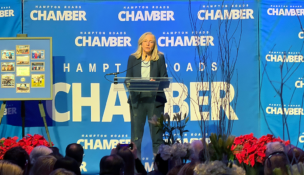Offshore windfall
Hampton Roads will be East Coast center for wind energy
Offshore windfall
Hampton Roads will be East Coast center for wind energy
Two massive wind turbines are scheduled to begin spinning off the coast of Virginia Beach by the end of 2020, providing electricity to 3,000 homes and paving the way for Dominion Energy Inc. to build the nation’s largest offshore wind farm.
And even amid the coronavirus outbreak, plans are still proceeding on course, says Dominion spokeswoman Ann Nallo. “The company is preparing to perform ocean surveys to determine the impact of the 2,600-megawatt Coastal Virginia Offshore Wind [CVOW] project on the ocean and sea life. These surveys will help support development of the project’s construction and operations plan for submittal to the Bureau of Ocean Energy Management later this year.”
The utility began construction on the $300 million pilot project in June 2019. Located 27 miles off the Virginia Beach coast, CVOW sits in 2,135 acres of federally owned waters leased to the Virginia Department of Mines, Minerals and Energy. The U.S. Bureau of Ocean and Energy Management awarded final approval to the project last fall. Dominion has contracted with Denmark-based Ørsted Energy to install two, 6-megawatt research wind turbines this spring manufactured by Spanish engineering firm Siemens Gamesa Renewable Energy.
The oceanic wind farm is the nation’s first offshore wind venture owned by an electric utility company, as well as the only permitted offshore wind project in federal waters. The U.S.’s first offshore wind project, the 30-megawatt Block Island Wind Farm in Rhode Island, began operating in 2016, and Rhode Island has another project underway. Maryland and Massachusetts also have commercial offshore wind projects in the works. New York signed the nation’s largest contract for offshore wind power last summer, a projected $5 billion deal totaling 1,700 megawatts in capacity.
The CVOW project is Dominion’s initial step toward an even greater endeavor — erecting 200 turbines in 112,800 acres of federal waters adjacent to the test turbines. Scheduled to be built in three, 880-megawatt phases from 2024 to 2026, the $7.8 billion commercial project will be capable of generating 2,650 megawatts of zero-carbon electricity at peak wind speeds to power 650,000 homes.
The utility has selected Spain-based Siemens Gamesa, a global market leader in offshore wind power, as its preferred supplier for the turbines, which will rise 600 feet from the ocean’s surface to the tip of the top blade, making each of the structures taller than the Washington Monument. Siemens Gamesa also will work with Dominion to evaluate supply chain development in Virginia for offshore wind as the state aims to become a national leader in the technology, management and deployment of offshore wind energy.
Dominion is continuing its work in creating a U.S.-based supply chain for offshore wind turbines in Hampton Roads, Nallo says, including collaborating with Siemens Gamesa during the COVID-19 pandemic.
Dominion is developing the larger wind farm as part of its ambitious initiative to achieve net zero carbon emissions by 2050. The utility, which has reduced its carbon emissions by more than 50% and methane emissions by 25% over the past 10 to 15 years, has said offshore wind power will be rate-based for its customers. “CVOW is intended to benefit our regulated customers,” says Nallo, “which requires the approval from the State Corporation Commission, just like any other power-generating facility.”
Shortly before Dominion announced the commercial project last September, Gov. Ralph Northam issued an executive order calling on state agencies to develop strategies for Virginia to produce 30% of its electricity from renewable supplies by 2030 and to be fully carbon-free by 2050. The executive order stipulated that an offshore wind farm generating 2,500 megawatts be constructed by 2026.
Meanwhile, this year the General Assembly passed the Virginia Clean Economy Act, requiring the state’s electric grid to be 60% carbon-free by 2036 and reach net-zero emissions by 2050. The sweeping legislation also increased the state’s offshore wind power generation goal to 5.2 gigawatts by 2034.
Along with providing a new source of renewable energy, the offshore wind farm could position Virginia as a supply chain hub for the U.S. offshore wind industry, bringing thousands of jobs to the state. Northam’s 2020 state budget included funding for an Office of Offshore Wind to support the state’s efforts to become a leader in the nascent industry, as well as $40 million for port upgrades to help drive investments in the offshore wind supply chain.
Additionally, Northam announced in January that Ørsted will lease part of Portsmouth Marine Terminal from the Port of Virginia to stage materials and equipment for its offshore wind projects across six states, including New Jersey and Rhode Island. “We have the potential to drive offshore wind for the entire East Coast,” Northam said in announcing the lease agreement. “We are so well-positioned in Hampton Roads with the port. It is one of Virginia’s top selling points.” He added that the region has the trained workforce and maritime knowledge necessary to become a vital hub for offshore wind development.
Ørsted will initially lease 1.7 acres at PMT through 2026, with the option to expand to 40 acres. Port officials say the agreement could amount to almost $13 million in lease payments and site upgrades of more than $20 million for cranes and other improvements to a section of the terminal’s berth to ensure heavy load capacity. One of the port’s two multiuse terminals in Norfolk Harbor, PMT covers 287 acres and offers on-dock rail access and open space for storage and staging. The investments will prepare the terminal for activities such as preassembly, staging and loading wind turbines as Ørsted installs almost 3,000 megawatts of wind energy projects up and down the East Coast that would power about 1.5 million households.
One of the world’s largest wind-energy developers, Ørsted will ship equipment to PMT, where it will be worked on and transported to offshore installation sites. The company believes Virginia will play a central role in the emerging industry, says Thomas Brostrøm, president and CEO of Ørsted North America, Offshore. “Virginia is a key player in offshore wind for America,” he adds. “Virginia has a world-class port and maritime workforce, and PMT is well-situated to meet our needs as we continue to expand in the U.S.”
Located on the west bank of the Elizabeth River, the terminal boasts modern facilities, deep-water channels and unobstructed overhead access, which officials say will give the state a competitive advantage in producing and moving offshore wind components. “PMT is a great asset,” Brostrøm says. “It has all the ingredients we really need for effective installation.”
The offshore wind industry will require multiple ports for staging and transferring components to sites off the East Coast, he adds. “This is a very vast industry emerging, and we’re going to see more investment in ports up and down the coast. We’re looking at a $70 billion industry in the next 10 to 15 years.”
Port of Virginia officials hope other offshore wind suppliers will share that view. “Our hope with PMT being a hub is that it will start to attract major suppliers,” says Cathie J. Vick, the port’s chief development and government affairs officer for the Virginia Port Authority. “As projects come online on the East Coast, our objective is to attract them to put facilities in Virginia, including blades, tower manufacturing and assembly of parts. They would use the port as a shipment center to other places up and down the East Coast.”
Offshore wind projects will help diversify and expand Hampton Roads’ substantial maritime industry, adds David C. White, executive vice president of the Virginia Maritime Association, a group that promotes commerce through Virginia ports. “There is the potential for thousands of jobs and for this area to be the epicenter for supplying offshore wind off the East Coast,” he says. “This is a once-in-a-generation opportunity.”


















